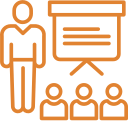There are five reasons why you should consider measuring the impact and ROI of your programs. However, there are situations where maybe you shouldn’t measure the ROI, but we will come back to that. First, let’s review what is involved when calculating ROI.
Essentially, an ROI evaluation requires evaluating the success of a learning program on five levels of outcomes. The first level is the reaction to the program in terms of relevance, importance, and intent to use. The second level is learning the knowledge and skills required to make the program successful. The third level, application, is tracking how the content has been used and how much success participants have had with its use, along with any barriers and enablers. The fourth level is impact – the connection of the program to key business measures. At this outcome level, steps must be taken to isolate the effects of the program on those measures and then convert the business measure to money and calculate the ROI. The fifth level, ROI, is the comparison of the monetary benefits of the program to the costs of the program.
Now that you know what’s involved in an ROI study, let’s discuss why you should be calculating the ROI of your programs.

















